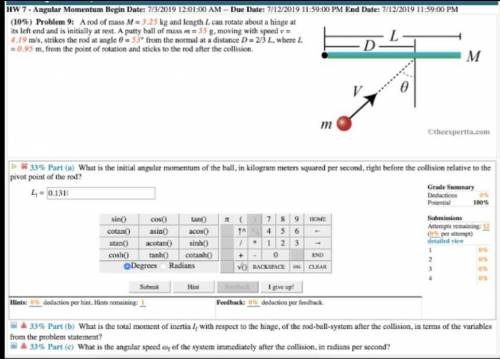
Physics, 12.12.2020 17:10 kyliearnell
A ping-pong ball is moving at 7.55 m/s at right angles to Earth’s 44.0 μT magnetic field. How much charge would you need to put on the 2.70 g ping-pong ball so that the magnetic force on the ball is equal in magnitude to the gravitational force on the ball? Assume g = 9.80 m/s2 . Note: The charge is unrealistically large!

Answers: 3


Another question on Physics

Physics, 21.06.2019 19:30
A33.1 g copper object is launched from a 1.5 m 30° steel incline positioned on the floor by being pulled up a string attached to a 50.0 g mass suspended vertically over a pulley. the object is projected towards a glass table where it lands when it is at the point along its trajectory with the lowest speed. it comes to a halt when it clears the opposite edge of the table. it then falls and lands on 9 physics texts each 5 cm thick that are stacked on the floor on the opposite side of the table. assume that the table does not have a ledge and the rectangular object experiences 0.05 n of air resistance as it falls towards the books. how far and how long did the object travel and how fast does it hit the books. assume that at the moment the copper object leaves the incline, the massless string and ideal pulley break off
Answers: 2

Physics, 22.06.2019 02:10
Astudent is performing an experiment comparing sound and light waves. the student gathers the following data. what conclusion does the student most likely make based on this data? light waves always travel the same speed; however, the speed of sound is determined by the medium that it travels through. all sound waves always have the same energy, so the temperature of the medium does not affect wave speed. light needs to vibrate particles, so it travels fastest in tightly packed solids, while sound does not need a medium, so it travels fastest in a gas. tightly packed particles in solids slow down the light waves; however, sound waves make particles bounce into each other, so they travel faster in solids.
Answers: 3

Physics, 22.06.2019 03:00
Arotating space station is said to create “artificial gravity”—a loosely-defined term used for an acceleration that would be crudely similar to gravity. the outer wall of the rotating space station would become a floor for the astronauts, and centripetal acceleration supplied by the floor would allow astronauts to exercise and maintain muscle and bone strength more naturally than in non-rotating space environments. if the space station is 200 m in diameter, what angular velocity would produce an “artificial gravity” of 9.80 m/s^{2} 2 at the rim?
Answers: 3

Physics, 22.06.2019 16:00
An charge with mass m and charge q is emitted from the origin, (x,y)=(0,0). a large, flat screen is located at x=l. there is a target on the screen at y position y(h), where y(h) > 0. in this problem, you will examine two different ways that the charge might hit the target. ignore gravity in this problem. 1.assume that the charge is emitted with velocity v(0) in the positive x direction. between the origin and the screen, the charge travels through a constant electric field pointing in the positive y direction. what should the magnitude e of the electric field be if the charge is to hit the target on the screen? express your answer in terms of m, q, y(h), v(0), and l. 2.now assume that the charge is emitted with velocity v(0) in the positive y direction. between the origin and the screen, the charge travels through a constant electric field pointing in the positive x direction. what should the magnitude e of the electric field be if the charge is to hit the target on the screen? express your answer in terms of m, q, y(h), v(0), and l.
Answers: 1
You know the right answer?
A ping-pong ball is moving at 7.55 m/s at right angles to Earth’s 44.0 μT magnetic field. How much c...
Questions

Biology, 15.01.2020 22:31



Mathematics, 15.01.2020 22:31


History, 15.01.2020 22:31




Mathematics, 15.01.2020 22:31


Arts, 15.01.2020 22:31

Physics, 15.01.2020 22:31


Mathematics, 15.01.2020 22:31





Biology, 15.01.2020 22:31




